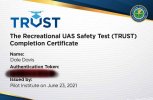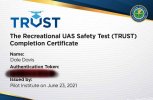I went ahead and took the TRUST course/test with Pilot Institute. I learned a couple of things, and I have a couple of comments:
1) The course confirmed something that I had suspected, and hoped was true. You can divide up the duties of VLOS on the drone, and watching the instruments, on screen or FPV. There are some easy restrictions, but it works. So maybe I'll find some young kid with awesome eyesight to do the VLOS thing, while I actually fly the aircraft.
2) Another good thing, which I didn't know, is that one registration is good for all the drones that you have. The registration is really of you, rather than a specific drone.
3) What's this CBO business? Community Based Organizations? How does THAT work?
4) NOTE TO PILOT INSTITUTE: Your course was quick and easy and well designed. But printing the cert was not! You need to move the content of the cert away from the margins of the page. If you're too cheap to pay the exorbitant cost of a full Acrobat license, like me, and you just use the Reader, you can't change the margins in the pdf, and the content gets cut off when you print it. I had to copy and paste the content into a Word file, and that worked...but it was unnecessarily clumsy.
I was hoping to get in at least one good flight today, but the wind has picked up beyond my comfort limits. At least I got this process task done.
Comments appreciated, particularly about CBO.
Thx,
TCS
1) The course confirmed something that I had suspected, and hoped was true. You can divide up the duties of VLOS on the drone, and watching the instruments, on screen or FPV. There are some easy restrictions, but it works. So maybe I'll find some young kid with awesome eyesight to do the VLOS thing, while I actually fly the aircraft.
2) Another good thing, which I didn't know, is that one registration is good for all the drones that you have. The registration is really of you, rather than a specific drone.
3) What's this CBO business? Community Based Organizations? How does THAT work?
4) NOTE TO PILOT INSTITUTE: Your course was quick and easy and well designed. But printing the cert was not! You need to move the content of the cert away from the margins of the page. If you're too cheap to pay the exorbitant cost of a full Acrobat license, like me, and you just use the Reader, you can't change the margins in the pdf, and the content gets cut off when you print it. I had to copy and paste the content into a Word file, and that worked...but it was unnecessarily clumsy.
I was hoping to get in at least one good flight today, but the wind has picked up beyond my comfort limits. At least I got this process task done.
Comments appreciated, particularly about CBO.
Thx,
TCS











